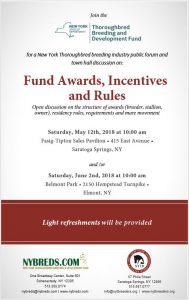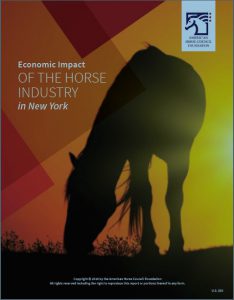From NYTB Executive Director Jeff Cannizzo: Save the Date & Make Your Voice Heard
 [1]To All Participants in the New York State Breeding and Racing Program:
[1]To All Participants in the New York State Breeding and Racing Program:
In the coming weeks the New York Thoroughbred Breeding and Development Fund (the Fund) will host two public forums for the breeding and racing industries, one in Saratoga Springs and one at Belmont Park. The aim is to elicit feedback from a broad spectrum of program participants about New York awards incentives and program rules.
Over the years, one constant for the Fund board has been engaging in dialogue with stakeholders. It is not unusual either for program participants’ feedback to spark spirited discussion at board meetings. That said, stakeholders do not, as a rule, reach out to the Fund Board to talk about what aspects of the program they support or think are working well. Generally, the people who speak out are advocating for various program tweaks. Moreover, the Fund has come to realize that most input comes from a relatively small group of voices.
The upshot is that, in order to serve all its stakeholders, the Fund board – on which I am the NYTB appointee – decided to create opportunities this spring for a greater number of interested parties to voice their opinions.
At this upcoming pair of town hall-style meetings, the Fund hopes to hear from a wide range of program participants. Issues likely to be covered include the structuring and percentages of the categories of awards (breeder, stallion owner, owner), the status of New York’s stallion roster and rules covering mare residency and breed-back. You can see a preview of some prospective topics by taking the Fund’s brief online survey[2].
The first public forum will take place on May 12 at the Fasig-Tipton Humphrey S. Finney Pavilion in Saratoga Springs. The second will be on June 2 at Belmont Park. Both meetings will begin at 10:00 a.m. and light refreshments will be provided.
Click here[3] for program flyer.
I would like to assure program participants, that no program changes are in the works. These forums and the Fund survey are simply part of a fact-finding mission so that the Fund board can get a clearer idea of the needs, opinions and suggestions of a broad cross-section of constituents. That said, the incentive program affects the lives and businesses of all, so I believe all participants should listen to what fellow stakeholders are thinking and make their views known.
I strongly urge you take the survey and to attend one or both meetings to listen and make your voice heard. I hope for a good turnout at both events and look forward to a lively and informative exchange of ideas.
Sincerely yours,
Jeff Cannizzo
Endnotes:- [Image]: https://www.nytbreeders.org/news/wp-content/uploads/2018/04/town-hall-invite-18-1.jpg?utm_content=Sarah&utm_source=VerticalResponse&utm_medium=Email&utm_term=Click%20here&utm_campaign=April%2020%2C%202018%20eNewsletter
- online survey: https://www.surveymonkey.com/r/FQ959M7
- Click here: https://www.nytbreeders.org/news/wp-content/uploads/2018/04/town-hall-invite-18-1.jpg?utm_content=Sarah&utm_source=VerticalResponse&utm_medium=Email&utm_term=Click%20here&utm_campaign=April%2020%2C%202018%20eNewsletter
Source URL: https://www.nytbreeders.org/news/2018/04/25/letter-cannizzo-letter-public-meetings/
Alpha colt is top New Yorker in opening session of OBS April
By Sarah Mace
A bay colt from the first crop of New York sire Alpha[1] was the top-selling New York-bred juvenile in Tuesday’s opening session of the four-day 2018 Ocala Breeders’ Sales Company’s April sale of 2-year-olds in training. Bred by Sequel Stallions New York[2] and consigned by Sequel Bloodstock, the youngster was purchased by David Meah for $120,000 on behalf of Team D, Circle B and John Holmes.
Tuesday’s transaction marks the second time Hip 67[3], who breezed a furlong in :11 flat in the under tack show, had come under the hammer. At the 2017 OBS yearling sale he went to Second Chance Racing for $14,000.
Foaled on March 12, 2016, the colt is out of Back in the Shade, a stakes-performing Florida-bred mare by Put It Back whose second dam Nabora is a stakes producer. Two of Nabora’s daughters are also stakes producers. Back in the Shade has produced two winners, topped by Jonker, a Japan-based colt by Exchange Rate who has earned $510,600. Sequel sold Back in the Shade for $4,500 at the 2016 Fasig-Tipton New York fall mixed sale, and her most recent reported foal by is a yearling filly by Forty Tales.
A second New York-bred 2-year-old to reach the six-figure threshold in the session was Hip 156[4], a dark bay/brown Bodemeister colt from the immediate family of $1.2-million earner and sire Musket Man.
Bred by McMahon of Saratoga[5] and foaled on April 6, 2016, the colt is a graduate of last summer’s Fasig-Tipton New York-bred preferred yearling sale in Saratoga, where he was purchased by Windswept Stables for $50,000.
Consigned at OBS by Top Line Sales LLC, Agent XV, the Bodemeister colt was purchased by trainer Linda Rice, who signed a $100,000 ticket for an undisclosed client following the colt’s :10.2-furlong work under tack.
The dam of Hip 156 is Casablanca Babe, a Kentucky-bred mare by Horse Chestnut (SAF) who was purchased by McMahon of Saratoga with the sale colt in utero for $50,000 from the Hidden Brook consignment at the 2016 Keeneland January sale.
Casablanca Babe is a half-sister to Musket Man. Ron the Greek, a multiple graded stakes winner, $2.7-earner and champion imported older male in Saudia Arabia appears under the third dam. On the track the mare won 12 races and earned over $200,000 and has been a consistent performer as a broodmare, having produced five winners from five foals to start.
Eighteen New York-bred juveniles were offered in the first session at OBS. Fourteen changed hands (including 2 private sales) for a 22.2% buyback percentage. The New York-bred average was $50,357 and the median checked in at $42,500.
The auction continues with Hips 307-612 on Wednesday, Hips 613-918 on Thursday and Hips 919-1222 on Friday. All sessions begin at 10:30 a.m.
Endnotes:- Alpha: https://www.bloodhorse.com/stallion-register/nytb/stallion/168468/alpha
- Sequel Stallions New York: http://www.sequelnewyork.com/
- Hip 67: http://obssales.com/aprcatalog/2018/67.PDF
- Hip 156: http://obssales.com/aprcatalog/2018/156.PDF
- McMahon of Saratoga: http://www.mcmahonthoroughbreds.com/
Source URL: https://www.nytbreeders.org/news/2018/04/25/alpha-colt-session-1-obs-april-18/
Equine industry thriving in New York: grows by $1.1 billion, adds 10,000 jobs
 [1](Joint press release from NYTHA, NYTB & NYS Thoroughbred Breeding and Development Fund)
[1](Joint press release from NYTHA, NYTB & NYS Thoroughbred Breeding and Development Fund)
Horses are big business in New York. The American Horse Council Economic Impact Study, published earlier this month, shows that the state’s Equine Industry has grown by $1.1 billion and added nearly 10,000 jobs since the New York Horse Racing and Agriculture Industry Alliance’s New York State Equine Industry Economic Impact Study of 2012. There are more than 154,000 horses stabled in New York.
The Equine Industry is the second largest agribusiness in New York, providing the state with $5.3 billion in economic impact, a 26% increase in the last five years and an eye-opening 121% growth rate since a study conducted in 2005. Employment opportunities in the industry have expanded by 28% since 2012, with horses generating 42,400 full-time jobs for New Yorkers. The horse industry also does its part for the preservation of green space. Approximately 1.3 million acres are currently used for horse-related purposes, and the equine industry is active in every one of New York’s 62 counties.
Thoroughbreds account for the largest segment of the state’s horse population, numbering more than 39,000.
“We are a labor-intensive industry,” said Joe Appelbaum, president of the New York Thoroughbred Horsemen’s Association, which represents more than 4,000 Thoroughbred owners and trainers. “That is particularly true of the racing industry, which boasts 80 jobs for every 100 racehorses. Horses are an invaluable asset for New York, and a thriving Equine Industry is vital to the state’s economy.”
State Senator John Bonacic, Chairman of the Senate Committee on Racing, Gaming and Wagering said, “The thriving equine industry in New York generates billions in economic impact and thousands of jobs for everyday New Yorkers, due in part the work of the Thoroughbred Horseman’s Association, New York Thoroughbred Breeders and the New York Thoroughbred Breeding and Development Fund. As Chairman of the Senate’s Racing, Gaming and Wagering Committee, I have worked hard to ensure that New York’s racing industry remains strong, and will continue to work with all the industry’s stakeholders to ensure its sustained vitality.”
New York State Assembly Racing & Wagering Committee Chair J. Gary Pretlow remarked, “As a result of the substantial economic impact provided by our equine industry, New York has garnered the reputation as one of the leading horse racing states in the country. My colleagues and I look forward to continue working with the industry leaders in further enhancing its applauded contributions.”
The racing sector of the Equine Industry is particularly robust, with a $3.08-billion total impact on the New York economy and $1.73 million in direct value while supporting 19,704 jobs. The numbers take into account direct expenditures (e.g. breeding, maintenance, training, insurance, veterinarians, jockey fees, transportation, etc.) plus indirect/induced economic expenditures (e.g. totalizer companies and other wagering technology, infrastructure, broadcasting, television, food and beverage concessions, track maintenance and security).
New York is one of the largest horseracing hubs in the United States, as highlighted by the AHC Study, with 11 racetracks throughout the state as well as hundreds of breeding farms and training facilities. Saratoga Race Course, one of the pre-eminent and oldest tracks in the country, attracts more than 1 million visits a year. In total, New York hosts 1,294 race days annually, offering purses of $289 million and generating $3.4 billion in handle.
“Once a confidence level was reached by Thoroughbred breeders and owners regarding our purses and incentive awards, our State-bred program positioned itself ahead of the rest of the national landscape,” said New York Thoroughbred Breeders Executive Director Jeffrey Cannizzo. “New York-breds are in demand in the marketplace, farms have reopened across the state and people are investing again in New York. This renaissance is creating hundreds of jobs and injecting needed revenue into communities across our state of New York.”
Cannizzo added, “Because incentive awards and lucrative purses have increased competition in the sales ring for top-tier New York-breds, breeders are putting extra resources and effort into breeding better horses. The quality of horses continues to improve in the sales ring and on the racetrack. In 2017, 16 New York-breds scored wins in 19 graded stakes, with three of those victories coming at the Grade 1 level across the globe.”
Tracy Egan, Executive Director of the NYS Thoroughbred Breeding and Development Fund, noted that the AHC findings line up with the improving picture for the state’s breeding industry.
“In 2017, breeders helped put 1,705 Thoroughbred foals on the ground in New York,” Egan said. “Those foals represent a 4.7% year-to-year increase in the foal crop, and a nearly 40% increase since 2011. Significantly, the increase in the number of foals occurs as the industry nationwide experiences a decline in foal crops. And the quality of New York-breds is now firmly established as year after year they win Graded and Group Stakes around the world. Currrently, New York-bred Audible confirms the trend will be a lasting one as he is one of the favorites for the Kentucky Derby on the first Saturday in May.”
Appelbaum concluded. “The AHC Economic Impact Study clearly demonstrates that the investment made in Thoroughbred racing and breeding through our share of VLT revenue has borne fruit. We thank Governor Andrew Cuomo, Senator John Bonacic, Assemblyman Gary Pretlow and all of our representatives for their support, which has helped to make our industry strong.”
Click here[2] for the complete New York Break-Out Report from the AHC Equine Industry Economic Impact Study.
Click here[3] for the highlights from the New York Break-Out Report.
Endnotes:- [Image]: https://www.nytbreeders.org/news/wp-content/uploads/2018/04/Study-cover.jpg
- Click here: https://nytha.us5.list-manage.com/track/click?u=ba2287c0ccea8583f37283499&id=0773ef6ffb&e=fd457af55b
- Click here: https://nytha.us5.list-manage.com/track/click?u=ba2287c0ccea8583f37283499&id=597e06f176&e=fd457af55b
Source URL: https://www.nytbreeders.org/news/2018/04/25/2017-ecconomic-impact-release/
 [1]To All Participants in the New York State Breeding and Racing Program:
[1]To All Participants in the New York State Breeding and Racing Program: [1](Joint press release from NYTHA, NYTB & NYS Thoroughbred Breeding and Development Fund)
[1](Joint press release from NYTHA, NYTB & NYS Thoroughbred Breeding and Development Fund)